Monday, July 12 we caught up on all our business, and talked to the girls and Patti. The weather had been nice. Highs have been in the 70’s, lows around 60.
After we went to an ATM we ventured to the
.JPG)
Museum of Ojibwa Culture where we saw beautiful
.JPG)
lilies blooming. There was a long bark house. Huron refugees settled on this site in 1671. The Huron, who were a settled agricultural people, built these huge permanent structures. There had been as many as
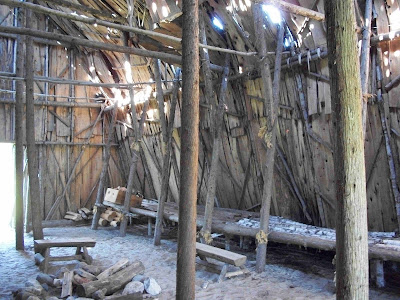.JPG)
ten longhouses in this village. Each house was inhabited by a grandmother, her husband, her daughters, their husbands and children. A son lived in the house of his wife’s mother.
.JPG)
Jacques Marquette, became a Jesuit priest in France in 1666. He sailed for the New World and studied native languages for two years near Quebec City. He served the Ojibwa mission at The Rapids of St Mary, the Huron at Chequamegon Bay, Wisconsin, and in 1671 to the Huron here at the Straits of Mackinac. He learned to be a chronicler, explorer, and cartographer, functions he assumed in 1673 when he accompanied Louis Joliet on the Mississippi River valley.
The Jesuit mission stood here and St Ignace continued to grow when French fur traders and soldiers, in the 1680’s built Ft deBuade to the south.
St Ignace was an important stop on the way to everywhere. Olivia enjoyed the
.JPG)
Indian artwork.
We had been told to be sure and eat at
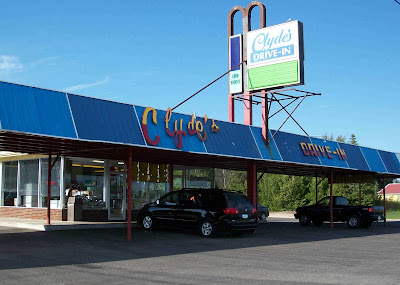.JPG)
Clyde’s Drive In for hamburgers, so we followed directions and enjoyed a delicious Jr burger. Don’t be fooled by seeing only two cars at the drive-in canopy. It was full inside. Now, who was it that told us to eat here? Was it Jon Bailey? Or someone in the Wednesday night Bible Study? Too many people have told us good places to see, do, and eat!
Tuesday, July 13, With everything in order, we were up early and headed to Canada, stopping for gas and a last US Wal-Mart stop in Sault Ste Marie, MI. The border crossing was larger than others we had been through and we were searched, but we were ok, so we were turned loose. Even though we know we are legal, it is always a stressful event. Legal except for being way over the small limit for cigarettes and wine.
The people in this part of Canada are very much like the people in the USA, they speak English! The big difference is they use the metric system. Gas is sold by the liter. 3,8 Liters per gallon. The roadside markers are in kilometers and kilograms. Our speedometer has both MPH and KPH so its not too difficult to drive at their posted speed. To find how far it is to the next town or attraction we multiply the posted distance in kilometers by .6. So if the posted distance to the next town is 60 kilometers, we multiply by .6 and know it is 36 miles. Bridge weights are a different matter. A sign may say the maximum weight is 20,000 kilograms. We have no clue what that is in pounds, so we just keep driving!
Canada has no paper money below five dollars. One and two dollars coins are common. Fred says it seems he always has $4.75 in coins in his pocket and it’s quite a load. You get used to it.
Heading north we searched for and found
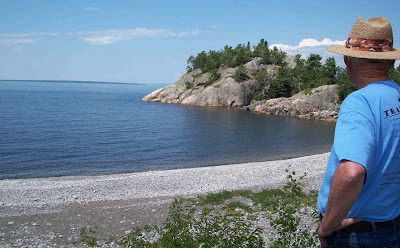.JPG)
Cecil’s (Olivia’s Dad) “Most Darling little cove” campground on Lake Superior. He wrote a whole page describing this spot. Now 35 years later the ground is the same, but the campground leaves a lot to be desired, but we stopped for the night.
The rocks attracted Olivia and we walked the beach a couple of times looking and yes picking up some of the
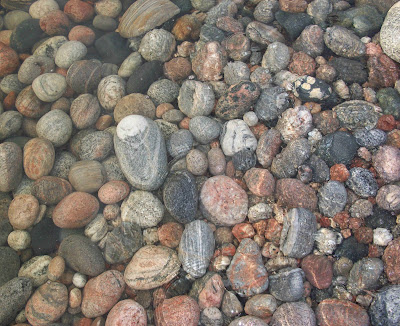.JPG)
“pretty rocks.” Our neighbors said to forget polishing rocks, just to spray them with acrylic and they shine really well. This picture of the rocks looks like a jigsaw puzzle we have seen in the tourist traps. After supper Olivia started to go pick up more rocks and a man passed and asked if she was going to pick berries. This changed our course immediately as we found wild blueberries and a few raspberries growing along the entry road to the park.
Our neighbors invited us to a campfire. They are teachers in Grand Rapids and he was full of fun songs to entertain us. We were interrupted with the
.JPG)
sunset on Superior and it was outstanding. When we told of hunting unsuccessfully for Petoskey stones, they immediately offered to send us some, as they have bunches. We just didn’t ask the locals where to find them. All told, we missed the Jones as they enjoyed picking up rocks and berries as well as hunting for Petoskey stones.
Wednesday July 14, we headed north over the last part of the TransCanada highway to be finished. It was the hardest part to complete because it is in the Canadian Shield. The Canadian Shield is Canada’s oldest mountain range, dating back millions of years. At one time their peaks were over 16,000 feet. Today they peak at about 4,000 feet. Glaciers and time have taken their toll. We passed
.JPG)
lake after lake after lake and
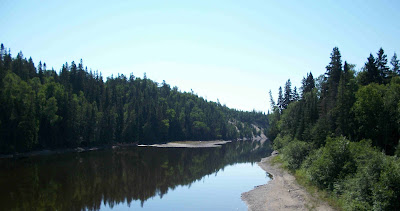.JPG)
rivers galore.
The electric jack on the trailer had been giving us trouble and not wanting to lift high enough, so we were hunting for a place to get it fixed or replaced. It’s not like it hasn’t been used! But if it goes out, we can’t hook or unhook.
We drove into Wawa, and stopped at the information center where the big goose was looking over the highway. This goose was placed in celebration of the completion of the TransCanadian highway.
.JPG)
We tried to fly like him, but for some reason couldn’t get off the ground.
The girl in the information center called and made us an appointment for a mechanic to look at the jack, so while we waited we drove out to
.JPG)
Magpie falls.
We waited for our appointment where we found they couldn’t help and by the time we left it was time to stop for the day. There was an RV park close by so we checked in.
As we were in the office another couple was also there and they were talking about the wild blueberries being ready, so you know us, we were all ears. They told us where to find them and we met them there. This patch was seven miles up the highway and then five miles on a gravel road. It is government owned and
.JPG)
the sign at the entrance stopped us for a few minutes. Knowing we were only using our hands we proceeded and ended up with eight cups in just about an hour. We both agreed it was much easier picking Diana’s freezer than by hand. There was a nice breeze and no “flies or “no see’ems” so it was a good day. Again the Jones would have enjoyed this.
.JPG)
See what you are missing!
Thursday July 15 started off on the wrong foot. The electric jack wouldn’t go up, so we couldn’t hook on. The
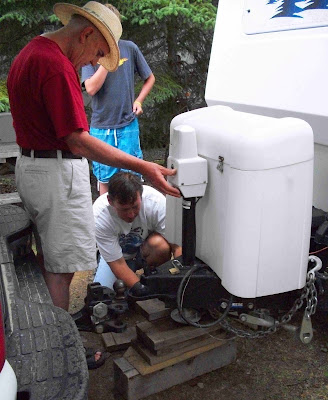.JPG)
owner of the campground & son came to help, we all scratched our heads, used blocks, etc. Then a neighbor heard we needed a jack and came to our rescue, jacked up the trailer, and we hooked on. RV people are so nice! We figured we wouldn’t be able to unhook until Thunder Bay, which would hinder our sight seeing. Ralph where were you with your good jack? The park owner didn’t think there was anyone before Thunder Bay and gave us repair place names.
Fred also knew one of the trailer tires had been low, so before leaving town we went to a tire place before we ended up stranded on the lonesome highway. Sure enough there was a nail in it. We rolled on west on the TransCandian highway past White Lake which is the birthplace of “Winnie the Pooh.” Olivia tried to
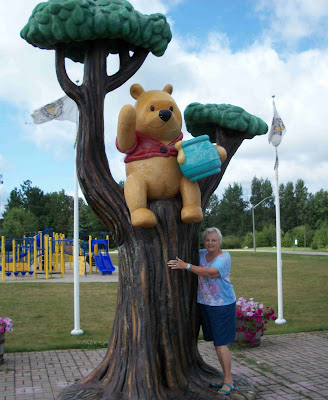.JPG)
hug the tree to get some honey.
Further west we past a huge
.JPG)
gold mine. There have been three here, but now only one large one. We passed many
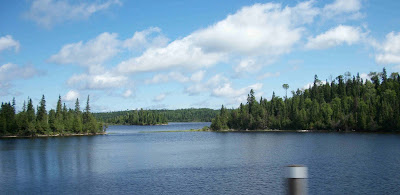.JPG)
pretty lakes too.
At Marathon we decided to see if there was anyone with trailer supplies and check the lug nuts on the repaired tire. We found this town a little larger, with a population of 3,700, than the other towns we had been through. Sure enough at a Canadian Tire store they knew of the tire place and Major’s Fabrication Shop who also had trailer supplies. Whoopee! And he had just the thing. We had checked the catalogs and the price he quoted for the most expensive one in the catalog was a lot cheaper. Not only that, he didn’t charge for the installation. Were we impressed! Our old jack had a lift rating of 2,500 pounds. The new one is rated at 3,500 pounds. We were living right! Thank you God!
The town of Marathon had a
.JPG)
beautiful view from one side and a beach on the other.
The beach was called Pebble beach and the view to the
.JPG)
East and to the
.JPG)
west was beautiful. A family was taking advantage
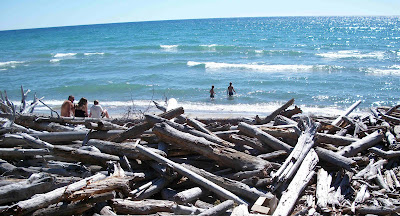.JPG)
of the sunny day.
May’s gift shop on the highway advertised free overnight camping for RV’s and we took advantage of the site behind the gift shop. Thank you May. The traffic along this stretch of highway was 45% trucks, 45% RV’s and 10% cars and they all stopped at night. So we slept undisturbed.
Friday, July 16 we drove west to Neys Provensal park to see the sights. This was the location of a WWII German
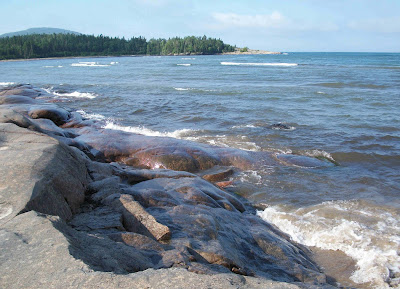.JPG)
Prisoner of War Camp. Wow what a place to be imprisoned.
The roadway took us over mountains and by some more
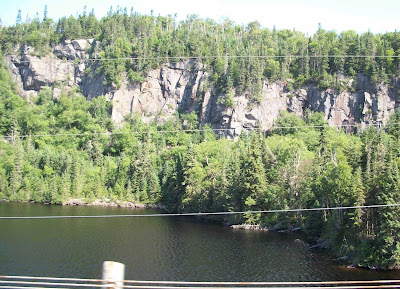.JPG)
pretty lakes.
In Terrace Bay we stopped to see the
.JPG)
Aguasabon Falls and canyon of Granodiorite, before moving on over some more mountains, through
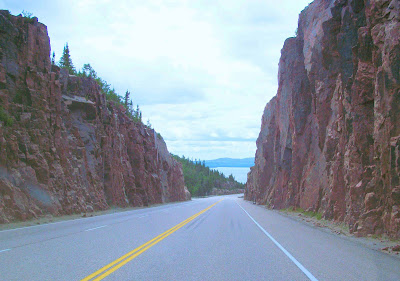.JPG)
rock cuts to see more of
.JPG)
Lake Superior. All along this TransCanadian highway we saw very few side roads and they were all gravel. The map shows nothing for about 100 miles north where another highway runs east and west. Then there are miles and miles of no roads all the way to the north pole.
We were really in the remote part of Canada. What was more surprising was the highway was a good paved smooth road with passing lanes when needed.
At Schreiber we were at the most northern point of Lake Superior and our turning south place. We were officially heading home.
We had planned to stop around Nipigon, but decided to move on just a little further because of the attractions there. However, this was not a good idea as we passed up good spots and then there were none. Deciding we would have to go all the way to Thunder Bay we stopped at the
.JPG) Amethyst Mine Panorama to mine some for ourselves. This open pit mine is 1100’ long, 54’ wide and 40’ deep and has been in continuous operation since 1965.
Amethyst Mine Panorama to mine some for ourselves. This open pit mine is 1100’ long, 54’ wide and 40’ deep and has been in continuous operation since 1965.
The Legend of this mine is millions of years ago Bacchus, the god of wine was angered at the insults of man and vowed to let his tigers devour the first human they could catch. A beautiful princess named Amethyst was traveling from Lake Superior to worship at Diana’s Grotto on the highest hilltop. Hearing the tiger she climbed up to Elbow Lake hoping to escape by canoe. No canoe could be found so she quickly climbed into a nearby crystal cave and prayed for help. The goddess Diana hearing the maiden’s prayer sealed the princess safely into the cave. Bacchus, remorseful and ashamed poured red wine on the cave freeing the princess. The wine stained the crystals in the cave creating the beautiful gemstone Amethyst. These colored crystals are mined from the vugs and caves at Amethyst Mine Panorama.
Amethyst Crystals are one of the strangest objects in nature. It is not alive, yet it grows. A crystal attracts the same kind of materials of which it is composed, arranges them with great accuracy in geometrical forms and cements them together. Large vugs allow for growth of extremely large amethyst crystals, some up to 8” in diameter.
The color of amethyst ranges from pale reddish violet to dark bluish purple, sometimes side by side.
The miners use jackhammers, high-pressure water, picks, shovels and hand labor to carefully remove the amethyst.
They had many
.JPG) beautiful samples on
beautiful samples on .JPG) display as well as letting us into the reject piles
display as well as letting us into the reject piles .JPG) to pick up as many as we wanted to pay for. This area of Canada has the largest known deposit in the world. We found a good amount of
to pick up as many as we wanted to pay for. This area of Canada has the largest known deposit in the world. We found a good amount of.JPG) small stones to take home with us.
small stones to take home with us.
Some interesting facts about Amethyst are:
The name is derived from a Greek word meaning “not drunken”
Bishops traditionally wear an amethyst ring.
Amethyst symbolizes deep love, happiness, humility, sincerity and wealth.
By the time we finished mining we were exhausted! And no place to park the trailer. We tried a couple of places with no luck and were heading into Thunder Bay when we saw a sign. Even though they were full the owner took pity on us and let us stay in a roadway behind the office. We were thankful for anyplace. We slept the clock around.
Saturday, July 17 Another month since leaving home. We felt more rested and headed to Thunder Bay stopping at the
.JPG) Terry Fox memorial and information center. Terry was a courageous one-legged runner who embarked on a cross-country run for cancer research, “The Marathon of Hope.” This site stands near the place where he ended his 3,339 mile run, stricken with the disease that ended his life.
Terry Fox memorial and information center. Terry was a courageous one-legged runner who embarked on a cross-country run for cancer research, “The Marathon of Hope.” This site stands near the place where he ended his 3,339 mile run, stricken with the disease that ended his life.
We could see a great view of Thunder Bay as well as the .JPG) “Sleeping Giant” across the bay. Fred was surprised to learn Thunder Bay has a population of over 110,000.
“Sleeping Giant” across the bay. Fred was surprised to learn Thunder Bay has a population of over 110,000.
We found our desired camp ground at the city’s Chippawa Park on the coast of Lake Superior and south of downtown. It also offers an amusement park, fishing, and wildlife park.
We decided to take in the Fort William Historical Park which was at the end of their two week Rendezvous festival.
We experienced the heyday of the Canadian fur trade in the re-creation of the North West Company’s impressive inland headquarters. There were 42 authentic, buildings in this fort and today was their Celtic Knot Celebration. The Celtic culture made a significant contribution to North America and the globe. We watched the Highland games as young men.JPG) tossed logs as far as they could. Entering the Canoe Shed where large birch bark
tossed logs as far as they could. Entering the Canoe Shed where large birch bark .JPG) canoes were built.
canoes were built. .JPG) We saw examples of how fur traders adapted native technology for the company use. All of the young people working there were in period dress and character. Fred enjoyed visiting with them and asking challenging questions.
We saw examples of how fur traders adapted native technology for the company use. All of the young people working there were in period dress and character. Fred enjoyed visiting with them and asking challenging questions.
One young lady pointed to our sandals and ask why the toes showed and what the material was. Remember it is 1815. Fred told her we were from the Tejas province of Mexico and as we neared Canada after a months long journey wild beaver, curious about the material, had eaten holes in them. The sandals were made from the hide of a nauga, a wild animal found in Mexico. Somehow she kept a straight face.
We thought of Daniel, a member of PETA, as we entered the fur store, where we visited with the salesman about the quality .JPG) of beaver fur for the famous beaver hats. We saw
of beaver fur for the famous beaver hats. We saw .JPG) large bundles of furs ready for shipment.
large bundles of furs ready for shipment.
Outside we saw girls dancing the .JPG) Highland Fling for the entertainment of all. And went into the Great Hall for
Highland Fling for the entertainment of all. And went into the Great Hall for .JPG) for a “Scottish Tea.”
for a “Scottish Tea.”
For more information on this park go to http://www.fwhp.ca/
Sunday, July 18 we played lazy this morning then took a short ride being the Locavores, (someone who eats food grown or produced locally,) that we are we went hunting for locally grown food. We found three farms, but all were closed. Olivia went to the office and borrowed their internet and chatted with Angie.
The Chippawa park, a Thunder Bay park, held a .JPG) Melodrama “A street car named Chippawa,” and within minutes it was sold out. A local person sat next to us and filled us in on some of the names and locations. Instead of popcorn, they sold bags of wadded up paper balls to throw at the villain.
Melodrama “A street car named Chippawa,” and within minutes it was sold out. A local person sat next to us and filled us in on some of the names and locations. Instead of popcorn, they sold bags of wadded up paper balls to throw at the villain. .JPG) We threw till our arms were tired and still had balls to give to others. It was truly a fun afternoon and of course the hero won over the villain.
We threw till our arms were tired and still had balls to give to others. It was truly a fun afternoon and of course the hero won over the villain.
We learned that Thunder Bay had been two towns and the area had been called “Lake Head.” In 1970 they had an election with three names submitted: Lake Head, The Lake Head, or Thunder Bay. The two Lake Heads split the majority and Thunder Bay it became. But the locals still call it the Lake Head.
Monday, July 18, It was time to head to the good old USA. We enjoyed the beautiful Lake Superior and the Canadian Shield, but as usual we will be glad to be back to dollars and cents instead of looneys and tooneys, and our internet and cell phones.
One week was nice in Canada, but we were on the move everyday and that’s not our cup of tea. We had thunder showers and .JPG) beautiful thunder heads our last night in Chippawa park and after dark
beautiful thunder heads our last night in Chippawa park and after dark.JPG) the moon came out next to one.
the moon came out next to one.
Our next letter will be a little of Wisconsin as we cross over to the western upper peninsula of Michigan to complete the circle of Lake Superior. Will that be the WUP? What will they be called?
As usual we love hearing from you, so email us at Olivia@bobheck.com or FredHarrington@yahoo.com
the north end of IH-35 with a view of the city. Then construction began, lanes narrowed, and exits closed. We were trying to find a campground on the south end of town and the exit was closed. Yuck! It is hard enough to find our way through a city without construction, but isn’t that what summer is all about?
Duluth and the bays of the St Louis River from the ski lodge was tremendous. We would have liked to have stayed in one place for four days but when the office opened the next day we found we only had two nights in our spot, so we moved on. We could have moved to another spot, but if we move we MOVE.
very remote forest road, we gave up. The season just ended.
Big Top. This is another good way to use a ski lift area in the summer. This Chautauqua has been going on for more than 25 years and that night they were performing their original show “Riding the Wind,” a musical and big-screen visual portrait of Bayfield featuring the founding fathers and mothers of the Apostle Islands area with stories of Red Cliff and Old La Pointe.
one of the three main backers of this show was celebrating her 70th birthday with four days of events. Thursday & Friday night 200 of her best friends were invited to come in time for dinner, a glass of wine, and attend the show. Each were also given t-shirts and buttons to wear. Saturday night they were having a formal, black-tie dinner, then breakfast Sunday morning.
Native Americans, Apostle Islands, logging, rail roads, farming, canning, shipping, light houses, original settlers, big businesses, flood, ladies league, hotels, summer cottages, and ended with sailing. During the intermission
everyone enjoyed the fresh air and
Mary Rice thanked everyone for coming.
blueberry pie and ice cream and their high school show choir,
“Fire and Ice” performance on the street.
of all sizes, a lady
on stilts who walked the whole route and back.
lawn mowers blowing bubbles. Bodins Resort celebrated six generations in Washburn and a
restaurant celebrated
“Hangin’ Out” with laundry on the line. Another was
fishing, with helium fish balloons floating out the back. Lots of candy was thrown as well as T-shirts, Frisbees, hot dogs, and marde gras beads. They had many other unique and clever floats and Olivia sent pictures for several groups at home.
camp spot. That’s Lake Superior through the trees.
brownstone similar to our sandstone courthouse not only in stone, but in architecture as well. These are a few years older than our courthouse.
Washburn United Methodist Church then drove north to see Bayfield. Their population is only 611, but it looked larger with many old buildings and mansions. The population really swells in the summer. North of town we drove into their city park campground and were glad we had found a spot in Washburn, it is a lot nicer. Then at Red Cliff we visited their park and we were even more glad we had lucked into a spot in Washburn. Those other two camps would have worked just fine, but Washburn’s was prettier and more centrally located for our activities.
this intersection and thought it was cute.
